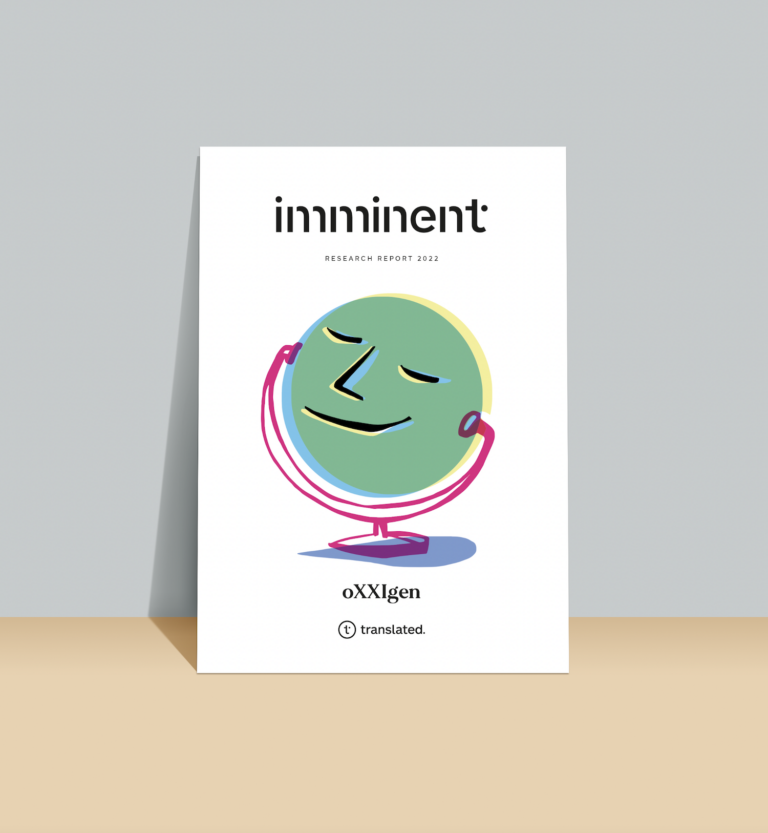Trends
We have asked this question to the major experts in the field of language, digital media and communication, strongly believing that their ideas are important to our multilingual and multicultural community. In 2020, the lockdown we have been forced to has increased the digital dimension and has evolved new multicultural communications, while experimenting the growing role of artificial intelligence in enabling multilingual communication. The ability to communicate in a multicultural environment has never been more important. We should be able to evaluate this importance as a new wealth genera- tor in terms of technology, culture, economy, society. We think that a set of answers like the one they provide us could gather facts and opinions so diverse and rich as to create a new knowledge of the importance of languages and multicultural relations.
Nikita Agarwal

Nikita Agarwal
Head of Milestone Localization
Nikita Agarwal heads Milestone Localization, a language company based out of Bangalore, India that works with businesses around the world to help them communicate across cultures. She started the company when she was 24 after spending three years traveling to Europe and China for business meetings where she worked with translators and interpreters and got introduced to the localization industry. Nikita speaks Hindi, Kannada and English and writes articles on entrepreneurship, marketing, languages and localization. Her native language is Hindi.
When was the last time you interacted with someone from another culture?
For most of us, the answer to this question will be ‘just a few hours ago’. We might have liked an article by a foreign journalist, commented on an international rap artist’s post, emailed a colleague who works at an overseas branch or sang along with someone on the other side of the world on TikTok.
The world today is more connected than ever before and more than 60% of the global population has access to online information, education, entertainment and people. We’re seeing a fusion of people, information and cultures which will have a massive impact on how we communicate- both online and offline.
The evolution of language in India.
“Mujhe job milgayee!” and “Mein kal se office ja raha hoon” translate to “I got a job!” and “I’m going to the office to- morrow”. If you don’t speak Hindi, you will still understand two words in the sentences above. In any city or town in India, if you know English, you can pick up bits and pieces of conversations in the local tongue and maybe even ascertain the topic of discussion.
This isn’t because Indian languages are similar in any way to English. What you are hearing is the modern/colloquial form of languages that are several centuries old.
South Asia is home to almost 25% of the world population. It is one of the most linguistically diverse regions in the world with more than a thousand languages and almost everyone is at least bilingual.
However, most Indians won’t be able to tell you the word for ‘office’, ‘engineer’ or ‘doctor’ in their mother tongue. Colonization, globalization, social media and foreign films have permanently changed languages in India.
The languages spoken in India today are an interesting mix of English with the regional tongue. Popularly known as ‘Hin- glish’ (Hindi and English), ‘Kanglish’ (Kannada and English) or ‘Telgish’ (Telugu and English), these hybrids are used by Indians of all ages and backgrounds in every part of the coun- try. Native speakers of Indian languages today generously mix English words in their speech and write their languages in the Latin script in Whatsapp and Facebook messages.
While conservationists, academics and purists lament the loss of our traditional languages and the imposition of English, what is happening with languages today is nothing new. The Hindi or Hindustani spoken today is a mix of Urdu and Sanskrit with Arabic influences. These hybrid dialects will continue to evolve and become increasingly important. While English will continue to have considerable influence on Indians, what’s more interesting to see is how Indians will counter-influence English and make it their own.
Societal trends and language.
Languages are a reflection of the society we live in. Around the world, cultures are merging due to immigration, international trade, social media and the influence of video games and pop stars.
As we move through the 21st century, the biggest factors affecting the growth and influence of language will be inter- net and smartphone penetration, pop culture, video games, immigration and population growth.
Even though Chinese has the most number of native speakers, it could never establish itself as a global language. It will further lose its importance if China continues to close itself and its online population from the world.
The other big languages- Spanish, Hindi, Arabic and French have growing populations and will continue to have tremendous importance in their geographical regions.
From this list, Spanish and Hindi will be stand out languages. By 2050, the US will have the largest Spanish speaking population in the world. Latin music and movies, population growth and economic progress in South America and immigration will further increase the importance and influence of the language internationally.
Hindi is the lingua franca of South Asia. As India’s economic might, population and soft power grow, so will the significance of Hindi. Already spoken by more than half a billion people, the influence of Hindi will be tied to the development in India and the popularity of Bollywood abroad.

oXXIgen
Imminent Research Report 2022
GET INSPIRED with articles, research reports and country insights – created by our multicultural interdisciplinary community of experts with the common desire to look to the future.
Get your copy nowThe global role and evolution of English.
While these languages will hold great importance in their respective regions, the most important global language of the 21st century will continue to be English. While the hard power of the west might be waning, its soft power is still considerable. Despite the inroads made by K-pop stars, Latin music, Punjabi rap and Japanese video games, Holly- wood and the US still have the strongest cultural influence on the world.
The English of the 21st century won’t be the English most of us were taught in school, with its idiosyncratic grammar rules and non-phonetic pronunciations. The English of the 21st century will be a mix of online slang, new acronyms and most notably, regional variations that are fully integrated with the local tongue.
‘Spanglish’, ‘Konglish’, ‘Chinglish’ and all the other hybrids are here to stay and most new words will never get a translation that will be used colloquially.
HINDI
पिछली बार, किसी दूसरी संस्कृति के व्यक्ति के साथ आपने कब बातचीत की थी?
इस सवाल पर, हम मंे से ज़्यादातर लोगों का जवाब होगा, ‘बस कुछ ही घंटे पहले’. हमने शायद किसी विदेशी पत्रकार के लेख को पसंद किया हो या किसी इंटरनैशनल रैप आर्टिस्ट की पोस्ट पर कमेंट किया हो. यह भी मुमकिन है कि हमने अपनी कंपनी की विदेशी ब्रांच मंे काम कर रहे किसी सहकर्मी को ईमेल भेजा हो या TikTok पर, किसी दूसरे देश मंे बैठे व्यक्ति के साथ गाते हुए कोई वीडियो बनाया हो.
आज की दुनिया में लोगों के बीच कनेक्टिविटी इतनी ज़्यादा है जितनी पहले कभी नहीं थी. दुनिया की 60% से ज़्यादा आबादी के पास इंटरनेट का ऐक्सेस है और लोग ऑनलाइन जाकर जानकारी, शिक्षा व मनोरंजन हासिल कर सकते हंै और एक-दूसरे से कनेक्ट कर सकते हैं. हमें जानकारी, लोगों और संस्कृतियों का संगम होता दिख रहा है और आने वाले वक्त में हमारी बातचीत के तरीके पर भी इसका बहुत गहरा असर पड़ेगा, फिर चाहे वह बातचीत ऑनलाइन हो या ऑफ़लाइन.
भारत मंेंे समय केे साथ भाषा मंेंे आया बदलाव:
“मुझे जॉब मिल गई!” और “मैं कल से ऑफ़िस जा रहा हँू”
ऊपर दिए गए इन दो वाक्यों का मतलब क्रमश: यह है – “I got a job!” और “I’m going to the office tomorrow”
हिन्दी न बोलने वाले व्यक्ति को भी, ऊपर लिखे गए वाक्यों के दो शब्द समझ आ जाएँगे. चाहे आप भारत के किसी भी शहर या कस्बे में हों, अगर आपको अंग्रेज़ी आती है, तो वहाँ की स्थानीय भाषा में होने वाली बातचीत का थोड़ा-बहुत अंश आपको समझ में आ जाएगा. यह भी मुमकिन है कि आपको बातचीत का विषय समझ मंे आ जाए.
इसकी वजह यह नहीं है कि भारतीय भाषाएँ अंग्रेज़ी से मिलती-जुलती हैं. आजकल जो भाषाएँ बोली जाती हैं वे सदियों पुरानी भाषाओं की आधुनिक/आम बोलचाल की शैली हैं.
दुनिया की करीब 25% आबादी दक्षिण एशिया में रहती है. यह दुनिया के सबसे ज़्यादा भाषाई विविधता वाले क्षेत्रों में से एक है. यहाँ 1000 से भी ज़्यादा भाषाएँ बोली जाती हैं और लगभग हर व्यक्ति कम से कम दो भाषाएँ बोल सकता है.
हालाँकि, ज़्यादातर भारतीयों को यह नहीं पता होगा कि उनकी भाषा में ‘ऑफ़िस’, ‘इंजीनियर’ या ‘डॉक्टर’ को क्या बोलते हैं. उपनिवेशवाद, वैश्वीकरण, सोशल मीडिया और विदेशी फ़िल्मों, इन सभी ने भारत की भाषाओं को हमेशा के लिए बदल दिया है.
आज भारत मंे लोग अपने इलाके की भाषाओं को दिलचस्प तरीके से अंग्रेज़ी के साथ मिलाकर बोलते हैं. ये मिली-जुली भाषाएँ ‘हिंग्लिश’ (हिन्दी और अंग्रेज़ी), ‘कंग्लिश’ (कन्नड़ और अंग्रेज़ी) या ‘तेल्गिश’ (तेलुगु और अंग्रेज़ी) के रूप में लोकप्रिय हैं जिन्हंे भारत के हर हिस्से में हर उम्र और हर पृष्ठभूमि के लोग बोलते हंै. भारत मंे आजकल लोग अपनी भाषा के साथ अंग्रेज़ी के शब्दों का भरपूर इस्तेमाल करते हैं, फिर चाहे वह मौखिक बातचीत हो या फिर लिखित संवाद. साथ ही, वे Whatsapp और Facebook पर मैसेज करते समय, अपनी भाषाएँ लैटिन स्क्रिप्ट मंे लिखते हंै.
भाषा की शुद्धता के समर्थक, परंपरावादी और शिक्षा के क्षेत्र से जुड़े लोग पारंपरिक भाषाओं के इस तरह खत्म होने और अंग्रेज़ी को थोपे जाने को लेकर दुख व्यक्त करते हैं, लेकिन भाषाओं में होने वाला यह बदलाव नया नहीं है. आज जो हिन्दी और हिन्दुस्तानी भाषा बोली जाती है वह उर्दू और संस्कृत के मिलने से बनी है और उस पर अरबी भाषा का असर है.
अलग-अलग भाषाओं से मिलकर बनी ऐसी बोलियां लगातार विकसित होती रहंेगी और इनकी अहमियत भी काफ़ी बढ़ जाएगी. भारतीयों पर अंग्रेज़ी भाषा का असर बढ़ना जारी रहेगा, लेकिन दूसरी ओर, यह देखना भी मज़ेदार रहेगा कि भारत के लोग, अंग्रेज़ी भाषा पर किस तरह असर डालंेगे और उसे अपने मुताबिक ढाल लेंगे.
समाज केे रुुझान और भाषा:
भाषाएँ हमारे समाज का प्रतिबिंब होती हैं. लोगों के विदेशों मंे जाकर बसने, अंतरराष्ट्रीय व्यापार बढ़ने, सोशल मीडिया और वीडियो गेम्स व पॉप स्टार्स के प्रभाव के कारण दुनिया भर में विभिन्न संस्कृतियों का संगम हो रहा है.
21वीं सदी जैसे-जैसे आगे बढ़ेगी, वैसे-वैसे भाषाओं के असर और विकास पर कुछ चीज़ों का सबसे ज़्यादा असर पड़ेगा. ये चीज़ें हंै: इंटरनेट और स्मार्टफ़ोन का ज़्यादा इस्तेमाल, पॉप कल्चर, वीडियो गेम्स, लोगों का दूसरे देशों में बसना और जनसंख्या का बढ़ना.
दुनिया मंे सबसे ज़्यादा लोगों की मातृभाषा चाइनीज़ है. इसके बावजूद, यह भाषा वैश्विक भाषा नहीं बन पाई. अगर चीन खुद को और अपने ऑनलाइन मौजूद लोगों को इसी तरह दुनिया से अलग-थलग रखेगा, तो चीनी भाषा की अहमियत और कम हो जाएगी.
दूसरी सबसे ज़्यादा बोली जाने वाली भाषाएँ हैं: स्पैनिश, हिन्दी, अरबी, और फ़्रंेच. इन भाषाओं को बोलने वाले लोगों की संख्या बढ़ती जा रही है और इन भाषाओं की अहमियत, इनके भौगोलिक क्षेत्रों में लगातार बनी रहेगी.
इनमें से भी स्पैनिश और हिन्दी सबसे प्रभावी भाषाएँ होंगी.
2050 तक, दुनिया में स्पैनिश बोलने वाले लोगों की सबसे ज़्यादा संख्या अमेरिका में होगी. लैटिन संगीत और फ़िल्मों, दक्षिण अमेरिका में जनसंख्या वृद्धि व आर्थिक विकास और स्पैनिश लोगों के दूसरे देशों में जाकर बसने की वजह से, दुनिया भर मंे स्पैनिश भाषा की अहमियत और इसका प्रभाव बढ़ जाएगा.
हिन्दी, दक्षिण एशिया में बोली जाने वाली आम भाषा है. जैसे-जैसे भारत की अर्थव्यवस्था मज़बूत होगी, जनसंख्या बढे़गी और भारतीय संस्कृति, अर्थव्यवस्था और विदेश नीति के लिहाज़ से दुनिया पर भारत का प्रभाव बढ़ेगा, वैसे-वैसे हिंदी की अहमियत भी बढे़गी. हिन्दी बोलने वाले लोगों की संख्या फ़िलहाल 50 करोड़ से ज़्यादा है और भारत के विकास और विदेशों में बॉलीवुड की लोकप्रियता के साथ हिंदी का और भी ज़्यादा प्रसार होगा.
दुुनिया मेंंे अंंग््रेेज़़ी की भूूमिका और विकास:
ऊपर बताई गई भाषाओं की अहमियत, उनसे जुड़े इलाकों में काफ़ी रहेगी, लेकिन 21वीं सदी की सबसे महत्वपूर्ण वैश्विक भाषा के तौर पर अंग्रेज़ी अपनी जगह पर कायम रहेगी. हार्ड पावर के मामले मंे भले ही पश्चिमी देश कमज़ोर हो रहे हंै, लेकिन सॉफ़्ट पावर के लिहाज़ से इनका प्रभाव आज भी काफ़ी है. कोरियन पॉप स्टार्स, लैटिन संगीत, पंजाबी रैप, और जापानी वीडियो गेम ने लोगों की ज़िंदगी मंे अपनी जगह बना ली है, लेकिन इसके बावजूद, संस्कृति के मामले में हॉलीवुड और अमेरिका का प्रभाव अब भी सबसे ज़्यादा है.
21वीं सदी की अंग्रेज़ी, उस अंग्रेज़ी से अलग होगी जो हमने स्कूल मंे सीखी थी, जिसकी वजह यह है कि इस भाषा के व्याकरण के अपने अनोखे नियम हैं और इसका उच्चारण नॉन-फ़ोनेटिक है. 21वीं सदी की अंग्रेज़ी भाषा मंे, ऑनलाइन स्लैंग और शब्दों के नए छोटे रूप इस्तेमाल होंगे. खास तौर पर, स्थानीय भाषा के हिसाब से क्षेत्रीय विविधताएँ अंग्रेज़ी में काफ़ी देखने को मिलेंगी.
‘स्पंैग्लिश’, ‘कोंग्लिश’, ‘चिंग्लिश’ और अन्य भाषाओं के ऐसे ही मिले-जुले रूप अब लोगों के लिए आम हो गए हंै. साथ ही, ज़्यादातर नए शब्दों का कोई ऐसा अनुवाद नहीं हो पाएगा जिसे आम बोलचाल में इस्तेमाल किया जाता हो.
Maria Casadei

Maria Casadei
PhD student at the Jagiellonian University
Maria Casadei is a passionate young researcher of South Asian cultures and languages. She graduated in Languages, Cultures and Societies of Asia and Mediterranean Africa at the University of Venice, Italy. She pursued her studies at the University of Naples, with a specialization in Hindi and Urdu language. In 2021, Maria completed a three year course in Telugu language and literature at INALCO, Paris. Currently she is a PhD student at the Jagiellonian University, investigating the relationship between language, culture and Internet. Her native language is Italian. During her academic experience obtained both in Italy and France, she has been deeply involved in studying Indian literature, philosophy and religion. Her interests involve sociolinguistics, language and technology, media and cultural studies. Since 2019, Maria has collaborated as a translator and content writer with no-profit organizations and ONLUS working in Asia and in the Middle East in the field of cooperation and urban and social development.
I started studying languages and societies of Asia and Mediterranean Africa almost 7 years ago. Recently I decided to enroll in a PhD programme on sociolinguistics of Southern India. Whilst at the time the Chinese language was the most popular and requested language among the freshmen at the University, I decided to pick up Hindi and Arabic, which really seemed a silly choice. During the pandemic, the image and the role of China has slowly deteriorated leaving space to other countries to emerge. India is with no doubt one of them, representing a young and strong economy and a positive character within the Indo-Pacific region.
India is the most incredible and fascinating example of spread multilinguism and multilingualism in the world. The country hosts three different linguistic families: Indo-Aryan (a subfamily of the European), Dravidian and Munda. India has two official and national languages at the “union level”, which are English and Hindi. Moreover, the Eighth Schedule of the Constitution recognizes other 22 languages: Assamese, Bengali, Gujarati, Hindi, Kannada, Kashmiri, Konkani, Malayalam, Manipuri, Marathi, Nepali, Oriya, Punjabi, Sanskrit, Sindhi, Tamil, Telugu, Urdu, Bodo, Santhali, Maithili and Dogri. However, around 2.000 dialects are spoken within the country. The emerging role of India in the world’s dynamics and economy, strengthened further by its supremacy in the high-tech sector, underscores the importance of Indian languages (and here I am not referring to Hindi, but to state and regional level languages).
Climate change, migration and physical and mental dislocations are just a few of the biggest and hardest challenges to be faced in the next century. The phenomenon of migration is certainly not new but, in the future, it will be favored not only by wars and civil conflicts but also by the impacts of climate change on the environment, which will force people to leave their countries for a new home. As we can easily observe, year after year natural calamities are more frequent and violent causing unaffordable damages, especially in South Asian countries. According to experts, in the next century India, together with Sri Lanka and Pakistan, will be harshly affected by climate change, forcing a large part of its population to move and expatriate abroad. For this reason, the knowledge of languages like Tamil, Telugu, Punjabi, Marathi becomes important as well as the Sinhalese language, spoken in Sri Lanka, and Urdu, the official language of Pakistan.
The recent storming of Afghanistan by the Taliban lays the foundations for another frightening period signed by violence and religious repression. More than ever, Pashto, one of the minority languages of Pakistan and one of the main spoken languages in Afghanistan, is worth of interest and study since it would help overcoming many problems primarily related to the dislocation, reception and integration of refugees all around the world. Additionally, considering the ongoing civil conflict and wars in both Syria and Yemen, I believe Yemeni and Syrian dialects could be very useful in the future, especially in the field of cooperation, migration, social and urban development.
My feeling and personal approach towards languages lies on the idea that communication is fundamental to understanding the “other”. Many problems we are facing today are caused by ignorance and misunderstanding that could be easily avoided only if the world population were multilingual. We would be able to solve conflicts, to manage migration and integration successfully. When I say to people that I am studying Indian languages, they don’t really feel it is reasonable since it is well-known that Indians speak good English. This is partially true as only educated people have the possibility to receive an education and learn English at school.
Concepts like discrimination, segregation and bias have become very popular lately. Even though sometimes they seem to lose their original meaning due to the incessant use and misuse by media and business, some people are still convinced that in the next century our recovered consciousness will be the key for building a world based on new values. Globalization shapes the world we are living in, setting new boundaries or even erasing them. In this process, communication will be fundamental. To establish a new way of think- ing about co-existence and to create a more inclusive and sensitive world, the language barriers must fade away.
ITALIANO
L’India, con una delle popolazioni più poliglotte al mondo, è un affascinante esempio di multilinguismo. L’India due lingue ufficiali a livello nazionale, l’inglese e la hindi, ma la Costituzione indiana riconosce ben 21 idiomi, assamese, bengali, gujarati, kannada, kashmiri, konkani, malayalam, manipuri, marathi, nepali, oriya, ounjabi, sanscrito, sindhi, tamil, telugu, urdu, bodo, santali, maithili e dogri. Tuttavia, nel Paese vengono parlati oltre 2.000 dialetti. Nel prossimo secolo, l’India sarà riconosciuta come preziosa risorsa e superpotenza a livello mondiale. In questo scenario, le lingue indiane regionali saranno delle ottime compagne ed alleate per cogliere al meglio le opportunità che il Paese offrirà.
Il riscaldamento globale e la migrazione sono solo alcune delle grandi prove che affronteremo nel prossimo secolo. Il fenomeno migratorio non è certamente nuovo, ma verrà ulteriormente incoraggiato da guerre e conflitti, nonché dalle nefaste conseguenze del cambiamento climatico sull’ambiente, che costringeranno molte popolazioni ad emigrare. Le catastrofi naturali, sempre più frequenti e violente, causano ogni anno milioni di morti, soprattutto nei paesi del Sud Asia. Secondo gli esperti, nel 21esimo secolo, l’India, lo Sri Lanka e il Pakistan ne saranno gravemente colpiti, obbligando gran parte della popolazione ad espatriare. Lingue come tamil, telugu, punjabi, marathi ma anche il singalese, parlato in Sri Lanka e l’urdu, la lingua nazionale del Pakistan, diventeranno importanti per gestire ed affrontare il fenomeno della migrazione.
La recente presa dell’Afghanistan da parte dei Talebani segna l’inizio di un periodo caratterizzato dalla violenza e dall’oppressione religiosa, culturale e sociale. Il pashtu, una delle lingue minoritarie del Pakistan e tra le più parlate in Afghanistan (insieme al dari), meriterebbe di essere studiato ed approfondito, risultando utile per operare non solo nel settore dell’immigrazione, ma anche della cooperazione, progettazione e sviluppo.
Alla base delle scelte che mi hanno portata ad intraprendere questo percorso, vi è l’intima convinzione che comunicare sia la chiave dei rapporti tra esseri umani, necessaria per un corretto funzionamento della società. Anche se a volte opera in maniera inconscia e invisibile, la comunicazione è fondamentale per conoscere, comprendere, identificare e costruire l’immagine e la percezione dell’altro. Oggi molti conflitti nascono dall’ignoranza e da incomprensioni tra popoli con culture, religioni e vissuti differenti.
Quando dico alle persone che sono specializzata in lingue dravidiche dell’India, la reazione è sempre più o meno la stessa: stupore ed interesse seguiti da una domanda: “Ma a cosa serve? Gli indiani parlano tutti l’inglese”. Questo è vero solo in parte, poiché soltanto una piccola percentuale della popolazione indiana può intraprendere un percorso di studi, ricevere un’educazione e dunque imparare l’inglese a scuola. La domanda è assolutamente legittima, ma mette in luce come il nostro pensiero si basi spesso su false convinzioni che tendono ad accrescere le barriere linguistiche, ostacolando nuove possibilità di dialogo. Se questo ragionamento prevale, si continua ad ignorare una parte del mondo, costruendo una visione approssimativa, generale e limitata delle infinite realtà che ci circondano.
Nel periodo post-pandemico, si utilizzano spesso termini come inclusività, discriminazione, parità ed uguaglianza. Concetti che pian piano sembrano perdere il loro vero significato e che oggi sono riconosciuti come i “valori” che andranno a costruire il mondo del futuro, condizionato dalla globalizzazione e dalle innovazioni tecnologiche. In tutta questa nuova fase che ci attende, la conoscenza e l’apprendimento di lingue “oltre oceano” ci offre una via per ripensare al modo in cui viviamo e percepiamo la comunicazione e la coesistenza tra esseri umani.
Sam Wukui Bao

Sam Wukui Bao
Once a student in architecture, Sam Wukui Bao later discovered his passion for language and culture. He pursued translation studies at Guangdong University of Foreign Studies and Middlebury Institute of International Studies at Monterey, while actively engaging in translation projects with various social and cultural institutions. Having obtained his master’s degrees, Sam Bao further honed his skills through an internship at the Chinese Translation Service, United Nations Secretariat, assisting in translating summary records of U.N. conferences and provisional agenda items of the 74th General Assembly. Since then, he has been working in the gaming industry, providing simplified Chinese translation for high-profile products.
Before we enter the discussion, it is worth acknowledging that there is often a personal motive (and a most important one, I would reckon) for learning a particular language. If one is somehow interested in, say ancient India, then the lan- guage of choice is perhaps Sanskrit. And oftentimes, when we name a language, we are actually referring to a catch-all term that groups together many variants. Thus, it is a good practice to have the specific socio-geographical context in mind when applying a language.
Generally speaking, I think the six official languages at the U.N., namely, Arabic, Chinese, English, French, Russian, and Spanish, are still going to be among the essential ones to learn for the foreseeable future. Each of them possesses at least two of the following traits: spoken by a huge popula- tion, covering an expansive mix of geological locations, high- ly represented in region(s) of immense economic and/or po- litical significance. Of the six, Spanish holds special potential, as the Hispanic population in the United States is steadily growing in size and influence, and the U.S. will continue to be a, if not THE, global leader on so many fronts.
I would like to further elaborate on another language in the club, one that has seen a dramatic increase in its heft, with tremendous promise yet to be fulfilled. That one is Chinese, and specifically, Mandarin as the spoken form and Simpli- fied Chinese as the written form. This is, unsurprisingly, the single dominant version in mainland China (Singapore also adopts this combination). The importance and usefulness of this language are multi-faceted. Firstly, the Chinese main- land today represents a vast market, frequently one of the biggest on earth, with an expanding middle class craving for goods from around the globe.
Not only are multinationals profiting from this gold mine by setting up branches locally, but the Chinese consumers are shopping for products from overseas through e-commerce sites worldwide. One retailer of globally-sourced items, op- erated by Taobao, China’s biggest online shopping platform, alone has more than 45 million subscribers at the time of writing. Secondly, in the opposite direction, Chinese firms are increasingly going out to be investors and employers
in other territories. The controversy plagued Huawei and TikTok are the obvious front runners in this trend. Yet how many have realized that the movie Downton Abbey and the upcoming Jurassic World Dominion share a Chinese funder, a big part of whose portfolio consists of films never even screened in mainland China’s theaters? Thirdly, contempo- rary China has once again become a top sender of emigrants to the rest of the world, which already have Chinese com- munities long established almost everywhere. The stream of people settling abroad is likely to hold steady even as the country keeps growing wealthier.
This is because, unlike in the past, those who try to secure residence overseas often already belong to a well-to-do class. What they seek are not necessarily better economic opportunities but something else. Fourthly, On the back of its economic and technological strength, China is becom- ing a heavy-weight player in international politics, growing ever more assertive. How others respond to China’s rise, as much as China’s rise itself, will have profound impacts on the global political landscape. In my humble opinion, a wise approach to the matter is understanding this country from within, and learning its language is indispensable to that understanding. And finally, the great potential of Chinese as a second language in part lies in a massive imbalance. If translating into one’s A language is still going to be upheld as an industry standard, then there is a yawning market gap for Chinese-B translators. In the Chinese-English pair alone, into-English translations are still overwhelmingly done by Chinese natives.
In addition to the six languages discussed above, German, Japanese, and Korean each deserve a spot on the list. Ger- man-speaking (predominantly or partially) countries are themselves influencers on the world stage (did you know that aside from the six offices for the official languages at the U.N. Secretariat, there is also a German Translation Sec- tion?) and the language’s status is further elevated by Ger- many’s central role in the EU, whose moves often send rip- ples around the world. Japanese’s spot is granted because of Japan’s unabated role as an economic, technological, and cultural powerhouse globally.
The case for Korean is two-pronged. The first is that South Korea, following Japan, is establishing itself as an Asian star whose economy, technology, and culture shine light beyond the continent. The second is that North Korea, despite being arguably the most isolated country on earth, is paradoxically one that the rest of the world cannot afford to overlook.
CHINESE
在进入讨论之前,值得指出的是学习某一门语言往往有着属于个人的 动因(笔者认为这也是 极其重要的一个动因)。比方说,如果一个人出于 某种原因对古印度感兴趣,那么应该选择的语 言或许是梵文。此外,很 多时候当我们说出一门语言的名字时,我们实际上说的是一个笼统的 名 称,涵盖了许多的变体。因此,在运用一门语言时注意具体的社会地 域背景是一个良好的做法。 一般而言,我认为联合国的六门官方语言,即阿拉伯语、汉语、英语、法 语、俄语及西班牙 语在可预见的未来仍将属于必须得到掌握的语言。这 其中每一门语言都具备以下至少两种特征:有数量庞大的使用者、覆盖 范围广泛的地理区位、其高度使用的地区在经济和/或政治上有着极高 的重要性。在这六门语言中,西班牙语具备特殊的潜力,这是因为美国 拉丁裔群体的人口与影响 力正稳固上升,而美国在诸多方面即便不再 会是首屈一指的领头者,也仍将会是领头者之一。 笔者想在此详细谈一谈以上六门语言中的另外一门,这门语言的分量 实现了迅猛的提升,且 仍有着尚待实现的巨大潜力。这门语言就是汉 语,具体而言,是以普通话作为口头语言,以简体 中文作为书面语。这也 毫不意外地是中国大陆唯一处于主导地位的汉语版本。(新加坡亦采用 此 一组合。)汉语的重要性与用处体现在多方多面。首先,如今的中国大 陆是一个庞大的市场,在 很多方面是全球最大市场之一,其日益壮大的 中产阶级渴求着来自世界各地的商品。不仅仅是跨 国企业们通过在当 地建立分部来从这座金矿中收获利润,中国的消费者也通过全球的电 子商务网 站选购来自海外的产品。中国最大在线购物网站淘宝官方运 营的一家零售商店出售着采购自全球 的货品,在撰写本文时,仅这一家 商店就有着超过 4500 万订阅者。第二,从相反的方向着眼,中 国的企业正愈发地走出国门,在异国他乡成为投资者和雇主。被种种争 议所困扰的华为和 TikTok 仅仅是这一趋势中的领跑者。又有多少人意 识到,在电影《唐顿庄园》以及将于不久后上映的《侏罗纪世界 3:统治》 有着同一个中国投资方,而这个中国投资方的电影项目中有很大一部 分 甚至从未在中国大陆的影院上映过?第三,当代中国再一次成为了向 世界各地输送移民的主要国 家之一,而几乎世界每一处都早已有华裔 族群扎根。即便随着中国逐渐走向富裕,迁居海外的人 流也仍可能持续 不减。这是因为,与过去不同的是,试图定居海外的中国人往往已经属 于富裕阶 层。他们寻求的未必是更好的经济机会,而是别的一些东西。 第四,依靠着其经济和科技实力,中国正在成为国际政治中的重量级成 员,其姿态愈发坚定。其他国家如何对待中国的崛起,同中 国的崛起本
身一样会对世界政治格局产生深深影响。依笔者拙见,在这一议题上明 智的做法是深 入地地去了解这个国家,而要想了解这个国家,学习它的 语言是不可或缺的。最后,汉语作为一 门外语的巨大潜力一部分是源自 于一项极端的失衡。如果说将自己的 A 语言作为译入语的做法仍 将是 行业标准,那么以汉语作为 B 语言的翻译人员有着巨大的市场缺口。仅 仅在汉语—英语这个 语对中,译入英语的工作绝大多数还是由来自中 国本土的译员完成的。 除了上述六门语言外,德语、日语及韩语(朝鲜语)均值得加入最重要的 语言行列。说德语 (不管是基本上说或者部分说)的国家自身在世界上 具有影响力(各位读者是否知道,在联合国 秘书处,除了为六门官方语 言所设的办公室之外,还有一个德语翻译科?),且德语的地位因德 国 在欧盟(其一举一动往往会在全世界泛起涟漪)扮演的核心角色而得到 进一步提升。日语得以 被纳入是因为日本依旧是全球范围内经济、科 技和文化的活力之地。而韩语(朝鲜语)能够加入 这一行列则有两个原 因。其一是韩国继日本之后,正稳固成为一颗亚洲之星,其经济、科技与 文 化的光芒在亚洲之外也仍然闪耀。其二是朝鲜虽可说是地球上最为 孤立的国家,但矛盾的是,它 同时也是不容全世界所忽视的一个国家。 眼界。不过在学习外语之前,这些政策制定者和商业领袖或许应先学会 化繁为简,用简单质朴的言辞打动人心,这样才能带来行为上的改变。 虽然未来的旅程是未知之旅,但已知的是,朴实的语言与明晰的沟通依 旧可以是制胜的法宝。

oXXIgen
Imminent Research Report 2022
GET INSPIRED with articles, research reports and country insights – created by our multicultural interdisciplinary community of experts with the common desire to look to the future.
Get your copy nowAlifya Thingna

Alifya Thingna
Alifya started her career as a professional French-English translator in 2014 and quickly rose to becoming an integral part of the sales and marketing strategy team at BITS Private Limited and BITS International, as she proactively championed language industry initiatives and took on more chal- lenging responsibilities. A passionate culture enthusiast and a strong advocate of women empowerment at heart, she also co-founded a language technology startup in 2019 (subsidiary of BITS) and took on a voluntary marketing role in the India chapter of Women in Localization. This year, she was invited to head a new division at BITS as the Chief Business Officer, where she will not only closely monitor the sales and marketing verticals, but will also look after the content strategy and the entire communication lifecycle for aspiring brands. Her native language is Marathi.
There are over 7000 languages worldwide and nearly every language represents a different culture. And yet, thanks to globalisation, people continue to come closer despite the cultural differences. Having said that, the mediums and nature of communication are changing every day; the modern world requires us to use a different language for social collaboration, for professional networking and for travelling.
Today, the top 10 frequently used languages are English, Mandarin, Hindi, Spanish, French, Arabic, Bengali, Russian, Japanese and German. If you consider what’s the most influential, English surely tops the list. With 375 million native speakers and 1.5 billion speakers globally, English is considered the mother tongue of the internet and computer technology. On the other hand, China is expected to become the world’s leading economy by 2050, so some might consider learning Mandarin Chinese to be advantageous from a glob- al power or a business standpoint. With data analysis, ma- chine learning, artificial intelligence and programming on the rise in the 21st century, some might even consider Py- thon as a language worth learning.
Language learning has traditionally depended on personal preferences, your association with certain cultures, your future plans and the availability of good learning resources. With the world changing rapidly and a general feeling of unrest being prevalent, if you asked me – what kind of communication is really relevant in the context of the 21st century, I would say it is the language of empathy. What the world needs now more than ever before, is the ability to see another’s perspective without any pre-conceived biases and build trust. This will create a rock-solid base to understand each other better, thereby enhancing your individual identity, culturally, socially and linguistically.
MARATHI
जगभरात ७००० विविध भाषा बोलल्या जातात. प्रत्येक भाषा म्हणजे जणू एक वेगळी संस्कृतीच. पण या संस्कृतींमधील फरकांमुळे दूरावण्या ऐवजी लोकं जागतिकीकरणाच्या प्रक्रियेमुळे जवळच येत आहेत. परंतु त्यांच्यामधील संवादाची माध्यमे आणि पद्धती यामध्ये मात्र दररोज बदल होत आहेत. आजच्या आधुनिक जगात समाज किंवा समुदाय म्हणून एकत्र येण्यासाठीची, व्यावसायासाठी जोडले जाण्यासाठीची आणि अगदी प्रवासासाठीचीही भाषा वेगळी असते.
जगभरात आज प्राधान्याने वापरल्या जात असलेल्या पहिल्या दहा भाषांमध्ये अनुक्रमे इंग्रजी, मँडरिन (चिनी), हिंदी, स्पॅनिश, फ्रंेच, अरबी, बंगाली, रशियन, जपानी आणि जर्मन या भाषांचा समावेश होतो. यात सर्वांत प्रभावी भाषा कोणती, तर अर्थात इंग्रजी! इंग्रजी ज्यांची बोली भाषा आहे, अशांची संख्या ३७ कोटी ५० लाख इतकी असून, जगभरात इतरत्र ही भाषा बोलणारे तब्बल १.५ अब्ज लोक आहेत; त्यामुळेच या भाषेला इंटरनेट आणि संगणक तंत्रज्ञानाची मातृभाषा असे म्हटले जाते. दुसरीकडे, सन २०५० पर्यंत चीन ही जगातील सर्वांत मोठी अर्थव्यवस्था होईल, असा अंदाज असल्याने मँडरिन (चिनी) भाषा शिकणे, हे जागतिक सत्तेची भाषा म्हणून किंवा व्यवसायाच्या दृष्टीने फायदेशीर ठरू शकेल, असे अनेकांना वाटते. एकविसाव्या शतकातील परवलीचे शब्द झालेल्या डेटा अनॅलिसिस, मशिन लर्निंग, आर्टिफिशियल इंटेलिजन्स आणि प्रोग्रामिंग या संकल्पनांच्या प्रभावामुळे काहींना पायथन ही पण शिकण्याजोगी भाषा वाटू शकते.
अगदी पारंपरिक दृष्टिकोनातून पाहायचे, तर भाषाशिक्षण हे वैयक्तिक आवड, काही संस्कृतींशी असलेली जवळीक, आपल्या भविष्यकालीन योजना आणि अध्ययनाच्या चांगल्या सुविधा यावरच अवलंबून राहिल्याचे दिसते; पण या सातत्याने बदलत चाललेल्या आणि कायमस्वरूपी अस्वस्थतेची भावना निर्माण करणाऱ्या आजच्या जगात, कोणत्या प्रकारचा संवाद खरोखर कालसुसंगत आहे, असे मला विचाराल, तर या एकविसाव्या शतकाच्या संदर्भाने सर्वांत महत्त्वाची असेल, ती सहकंपेची, करुणेची भाषा! इतरांचे दृष्टिकोन कोणत्याही पूर्वग्रहदूषित नजरेशिवाय पाहून एकमेकांत विश्वास निर्माण करण्याच्या क्षमतेची आत्ता जगाला सगळ्यात जास्त गरज आहे. यामुळे एकमेकांना अधिक चांगल्या रीतीने समजून घेण्यासाठीचा भक्कम पाया निर्माण होईल. सांस्कृतिकदृष्ट्या, सामाजिकदृष्ट्या आणि भाषिकदृष्ट्या तुमची वैयक्तिक ओळख अधिक समृद्ध होण्यासाठी ही हे गरजेचे आहे.
Vidushi Kapoor

Vidushi Kapoor
Vidushi graduated from Delhi University with a degree in Economics. After working with Ernst & Young and Goldman Sachs, her deep interest in Indian languages combined with a passion to solve complex problems, led her to join hands with veterans in the language technology space to co-found Process9. Nine years into the industry, she has helped build products & solutions for the various challenges brought forth by Process9’s clients, and has learnt to read and speak many new Indian languages along the way. She has spoken at forums hosted by FICCI, CITLoB and others. Her native language is Hindi.
The importance of what language you speak will keep reducing, as applications of AI-ML in translation keep improving. We already have prototypes in the market where eyepieces can scan any text/ image and translate it instantly; and earpieces that can listen to a foreign language and translate it to yours on the fly. Then, would it really matter if you’re in Tokyo and speak nothing but German? If everything you read and hear will be given to you in German, and everything you speak will be understood in Japanese?
(The only qualifier I’d add here is to learn a language that isn’t rare or almost extinct…!)
For many years now, it has been our ability to adapt to technology that has dictated our ability to communicate with people. At zero tech, you can only speak with people you meet physically and who speak your language. As your tech adoption increases – pens, phones, internet, video calls and MT enabled devices – your “circle of communication” can grow to potentially include every human being on the planet!
HINDI
अनुवाद मंे एआई एमएल के निरंतर विकास के साथ, आने वाले दिनों में आप कौनसी भाषा बोलते हैं, इसका महत्त्व कम होता जाएगा।
टेक्नोलॉजी की बदौलत, आज हमारे पास ऐसे चश्मे हैं, जो किसी भी पाठ या फोटो को स्कैन करके उसका तुरंत अनुवाद कर सकते हैं; ऐसी कान की मशीने हैं, जो कोई भी भाषा सुनकर उसे आपकी भाषा में बदलकर तुरंत आपके कान में बोल सकती हैं। तो फिर, क्या वाकई इस बात से कोई फर्क पडे़गा, अगर आप केवल जर्मन भाषा जानते हुए टोकियो में घूम रहे हों? जब आप सब कुछ जर्मन मंे पढ़ और सुन पाएंगे, और आपकी जर्मन मंे बोली बात दूसरा व्यक्ति जापानी मंे समझ पाएगा?
(बस इतना ही ज़रूरी है कि आपके द्वारा सीखी जाने वाली भाषा दुर्लभ या लुप्त न हो…!)
कई सालों से, औरों से जुड़ने की हमारी क्षमता, इस बात पर निर्भर रही है कि हम कैसी टेक्नोलॉजी का, और किस हद तक टेक्नोलॉजी का उपयोग कर पाते हैं। बिना टेक्नोलॉजी के, हम केवल उन्हीं लोगों से बात कर सकते हैं जो हमारे सामने हैं और हमारी बोली बोलते हंै। जैसे जैसे हम बेहतर टेक्नोलॉजी को अपनाएंगे – जैसे कलम, फोन, इंटरनेट, वीडियो कॉल और जल्द ही मशीनी अनुवाद सक्षम उपकरण – हमारा “संपर्क का दायरा” बढ़ता चला जाएगा और आने वाले कल में, यह इतना बड़ा हो जाएगा कि, भाषा की बेड़ियों से मुक्त होकर हम इस दुनिया के हर व्यक्ति से बात कर पाएंगे!
Zoe Qian

Zoe Qian
Zoe Qian is a Chinese-English-German conference interpreter and ATA-certified translator. She was born and raised in China, but has spent over a decade living, studying and working in Singapore, the UK, Germany and the US. She specializes in sustainable development, climate change and energy. She also edits and co-produces “Slow Chinese”, a weekly newsletter for Chinese learners and China watchers.
Life in the 21st century is indeed a journey into the unknown. The reality that we are part of today is science fiction twenty years ago. With no crystal ball in hand, I am not able to see beyond the ignorant present and grasp the future of lan- guage – or the world – in the instant. So do not expect me to name specific languages you should learn to navigate and sail through this century.
Every interpreter and translator will tell you that context matters. So when it comes to picking languages to learn, I would say learn the local ones. The 21st century will be characterized by movement, because we can (technology) and sometimes because we have to (climate change). Moving from one place to another almost always changes the linguistic environment as well, even if it means to move to another English-speaking country. Relocating from Singapore to the UK, I modified my accent and speech rhythm. Moving again from the UK to the US, I changed all “ise” to “ize” and started to call the dot placed at the end of a sentence “period” instead of “full stop.” We often talk about “adaptation” in the political discourse of climate change. On an individual level, learning local languages is one of the most effective adaptive measures that we can take to mitigate the shock that a change in environment can have on us.
“On the journey into the unknown and uncertainty, the power of simplicity and clarity remains a constant.”
For policy makers and business leaders, on the other hand, it is necessary to stay informed and pass on the knowledge, if they want to successfully navigate the Age of Change. Linguistically speaking, it means that they should learn languages from different parts of the world on the latest trends and solutions. Though most information is available in English, learning other languages – especially non-European ones – can paint a fuller picture. But perhaps more importantly, they must learn to use simple language to reach the hearts and minds of the people to effect change. Breaking complicated ideas down into small crystal-clear words dispels the perceived misty illusion of complexity and possibly even shines the way forward. On the journey into the un- known and uncertainty, the power of simplicity and clarity remains a constant.
Simplified Chinese
的确,21世纪的旅途充满了未知。当下对我们而言的现实,20年前 只出现在科幻小说中。我没有水晶球在手,无法拨开迷雾见未来, 不知道语言学习抑或是整个世界将何去何从。因此,让大家失望 了,我无法预测要在21世纪乘风破浪、成功渡劫,具体需要学哪几 个语言。 我们做翻译的都讲究语境,要具体问题具体分析,选择学什么语言 也是如此。我能给出的建议是去学习当地的语言。21世纪是人类大 迁移的世纪,我们有科技手段出行,有时也会由于种种原因(如气 候变化)不得不搬离熟悉的环境。从一个地方搬到另一个地方,也 常常意味着语言环境的改变。就算是从一个英语国家搬到另一个 英语国家,语言环境也不尽相同。从新加坡搬到英国,我改变了语 音语调还有说话的节奏;从英国再搬到美国,我把原来的单引号改 成了双引号,再把句号从引号外面挪到了里面。讨论气候变化议题 时,常常会提及“适应性”措施。那对个人而言,学习当地语言就是 一种有力的适应性措施,能帮助我们减缓环境改变带来的冲击。 而对政策制定者或商业领袖来说,需要实时掌握信息并将信息传 递给人民,才能在这多变的世纪立于不败之地。那这意味着要学习 什么语言呢?我认为他们应学习不同大洲的语言,以获取最新动 态,了解最尖端的科技。虽然说大部分信息是以英文为载体,但光 学英文并不够,还需学习其它非欧洲语言,才能有一个更加全面、 真正全球性的眼界。不过在学习外语之前,这些政策制定者和商业 领袖或许应先学会化繁为简,用简单质朴的言辞打动人心,这样才 能带来行为上的改变。虽然未来的旅程是未知之旅,但已知的是, 朴实的语言与明晰的沟通依旧可以是制胜的法宝。
Photo credits: Chris Turgeon, Unsplash
